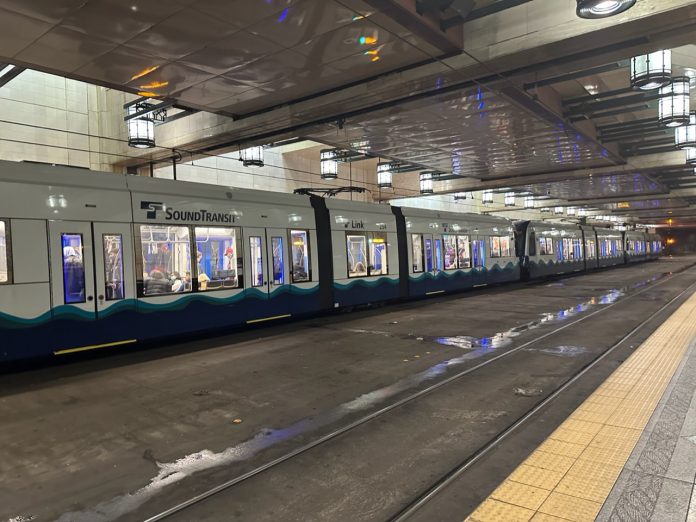
Sound Transit faces a serious predicament in how to provide service to Lynnwood. Compounding factors are piling up that spell trouble for the initial Lynnwood Link Extension opening, slated for summer or fall 2024. Those same issues are raising questions about what systemwide service and infrastructure needs might look like in the future.
Matt Sheldon, a Sound Transit planner, outlined the immediate problem to agency boardmembers this month. “We are using more light rail vehicles than we had planned to operate our current level of service on the 1 Line, which during peak rush-hour times runs every eight minutes between Northgate and Angle Lake,” he said. “There are a number of reasons for this…that boil down to longer running times, increased use of gap trains, which are trains we add to schedule to maintain even service frequency, lower than expected reliability of some of our fleet, and the need to keep more of the fleet out of service for maintenance.”
On top of this, the Lynnwood Link Extension of the 1 Line had always relied upon the East Link Extension for a two-line service and vehicle storage capacity at the Operations and Maintenance Facility (OMF) East in Bellevue. That project hasn’t gone smoothly and won’t be fully opened until at least spring 2025. Construction defects along the I-90 section have plagued the agency and will delay when light rail vehicles will be able to use it, though completing construction work on one of the tracks could give earlier access to OMF East storage. For now, Sound Transit is limited to vehicle storage and maintenance capacity west of Lake Washington and principally at the OMF Central in Seattle.
With only access to vehicles west of Lake Washington, Sound Transit cannot provide a two-line service through Seattle to Lynnwood. That dashes hopes of combined peak-hour headways being every four minutes, but the consequences are more dire.
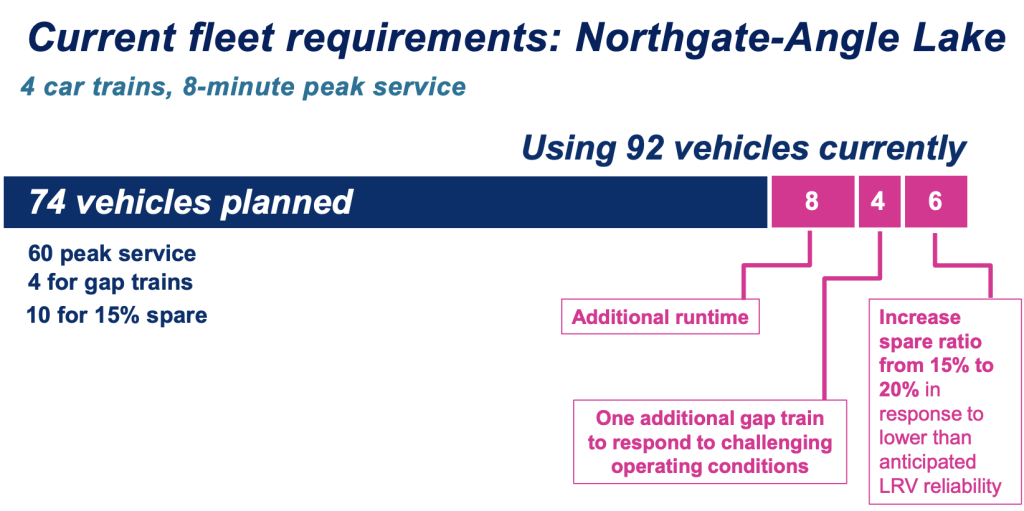
“As we planned for the Northgate Extension early in the last decade, we calculated that on a typical day we would need 74 light rail vehicles to provide eight-minute rush-hour service with four-car trains,” Sheldon said. “Of that, 60 cars would be needed to provide the actual service, four cars for a gap train to help us maintain the schedule, and 10 cars for spares and out of service for maintenance. Now that we’re operating the extension, we’re finding that we actually need an average of 92 vehicles to provide that same level of service.”
It appears that operational requirements are 24% higher than Sound Transit anticipated and means that the agency needs an extra 18 vehicles to fill several needs, though some of those may be passing issues as vehicles under warranty are fixed and targeted corrective measures are made to tracks.
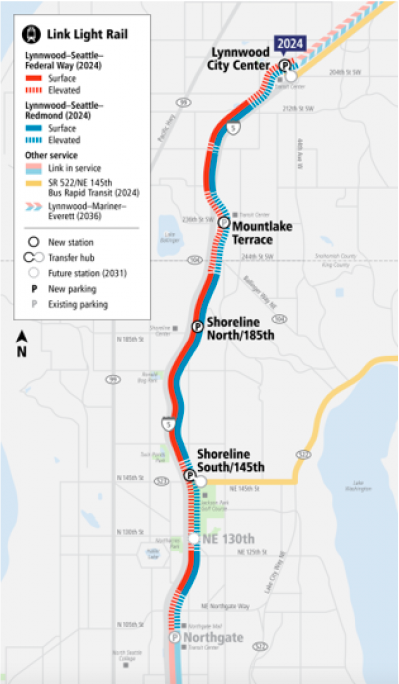
According to the agency’s estimates now, eight extra vehicles are needed for additional runtime. That’s heavily attributed to at-grade sections like the Rainier Valley and SoDo, but Sheldon also pointed to tunnels where there are some speed restrictions. Runtimes are about eight minutes higher end-to-end than the 50 minutes that the agency had budgeted for and those could go higher if additional speed restrictions are put into place. This also has a cascading effect where an additional gap train (four cars) is required. Spare ratio requirements are also higher than the 15% anticipated. The agency claims that a 20% spare ratio is required instead, which is ascribed to older vehicles needing refurbishment, slower certification of newer vehicles, and lower vehicle reliability, thus the agency believes an additional six spare vehicles need to be on hand.
Because of current constraints, Sheldon said that the agency is sometimes having to run three-car trains instead of four-car trains due to availability. With the agency stretched so thin now, the implications for service to Lynnwood are sobering, not least of which that four-minute peak-hour service won’t be possible initially, but the options at hand are all fraught.
“We will not have enough fleet available to provide initial eight-minute rush-hour service with all four-car trains,” Sheldon said. “We have found some opportunity for temporary storage outside of our OMF Central but it will not likely be enough to fill the gaps we see in providing rush-hour service. However, at this point, it looks like we will have enough vehicles available to provide 10-minute off-peak service, but that could become more difficult if running times grow any longer.”
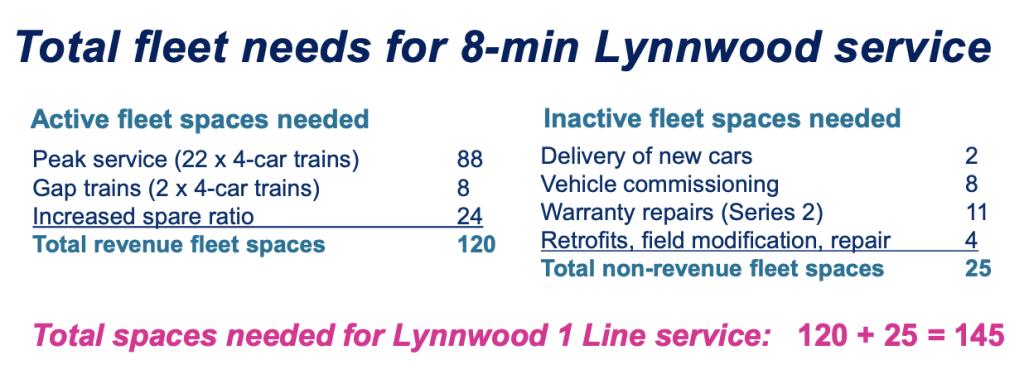
To provide the desired eight-minute headways on the 1 Line from Lynnwood to Angle Lake, Sound Transit needs enough storage space at OMF Central for 145 light rail vehicles (LRVs) that is simply not available in that yard. This includes 120 spaces for revenue service LRVs and another 25 spaces for non-revenue service LRVs. Breaking down the revenue service block, the agency needs storage capacity for 88 LRV cars for 22 trains, eight LRV cars for two gap trains, and 24 LRV cars for spares. The remaining 25 needed spaces are for things like new cars, vehicle commissioning, and vehicles undergoing repairs and retrofits.
Sound Transit reports that there is only enough storage space at OMF Central for 104 LRV cars. Another 20 potential overnight spaces could be available at other locations, with 12 LRV cars at Northgate and eight LRV cars at Angle Lake. Unfortunately, that still leaves the agency with a shortfall of 21 storage spaces and ultimately not enough to accommodate eight-minute peak-hour headways using four-car trains for the initial service to Lynnwood — unless other locations could be used for overnight storage, such as Lynnwood and pocket tracks.
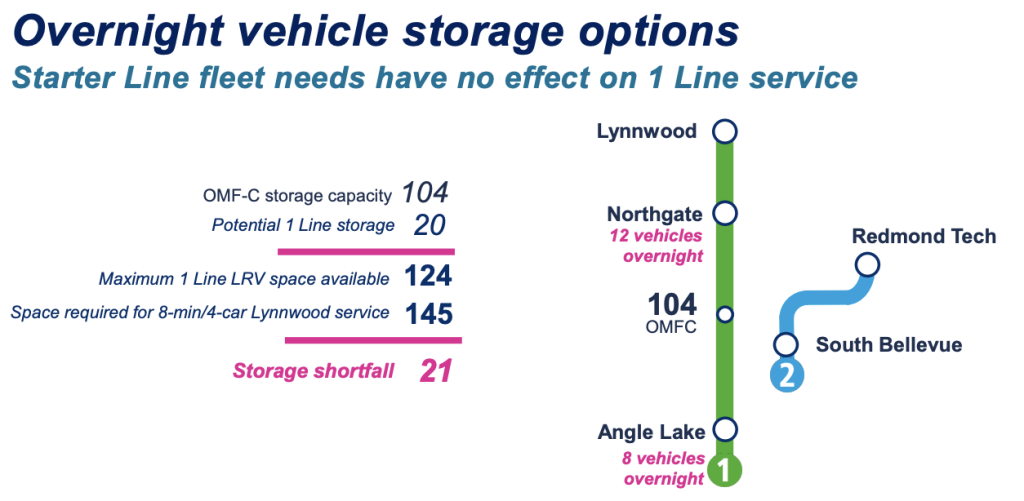
Something will have to give to support the extension, particularly at peak-hour times. Sound Transit is considering three broad options, which include:
- Running some peak-hour service with trains that have fewer cars to sustain eight-minute headways;
- Lengthening headways during peak hours to maintain four-car train service; and
- Providing higher service frequencies in some areas, such as overlaying extra service in the highest demand segments from Northgate through Downtown Seattle.
The agency will also consider a mix of these options, but all of the options mean that there will be more crowding between Northgate and Westlake Stations where ridership is highest. Leaving riders on platforms though because of over-capacity trains and operating the core at lower frequencies certainly would be a very bad look and start for the Lynnwood Link Extension, so finding additional storage capacity and considering creative operations approaches may be a wise thing for agency staff to work through.
In the coming months, Sheldon said that Sound Transit will further develop the options and coordinate with partner transit agencies to align service plans. The agency will also update forecasts for long-term fleet needs and financial assumptions.
That latter part sparked interest by Kristina Walker, chair of the Ridership Experience and Operations Committee. She asked if this process will ultimately result in a staff request to buy more vehicles.
“By the end of the summer, we want to have laid out for you what we think the implications of these pressures are on the system as we build it out,” Sheldon said. “We don’t have solid plans at this point for what to do about that.”
Continuing, Sheldon said, “I think we’ll bring some choices to you that could take the form of ‘hey, we want to keep as much service as we possibly can,’ that might require buying more vehicles, building bigger bases, things like that that are not currently in the program. It could also take the form of potentially changing our service expectations.”
Buying more equipment and upsizing storage and maintenance facilities certainly won’t come cheap and quickly, and neither will the added operations. But Sound Transit has long-promised riders and voters six-minute frequencies on Link lines and has already spent billions of dollars on a system with mediocre frequencies — frequencies that are still less than pre-pandemic levels. Failing to spend what is necessary to attain a reasonable measure of frequency permanently hampers the long-term function of the system.
Nevertheless, Sheldon hinted at a possible downgrade of service in his concluding remarks. “One of the pieces of information that we’ll introduce as we bring more to you through this summer is what do we think future ridership projections are looking like now and what level of service might be needed as opposed to what we planned for,” he said.
Stephen is a professional urban planner in Puget Sound with a passion for sustainable, livable, and diverse cities. He is especially interested in how policies, regulations, and programs can promote positive outcomes for communities. With stints in great cities like Bellingham and Cork, Stephen currently lives in Seattle. He primarily covers land use and transportation issues and has been with The Urbanist since 2014.




